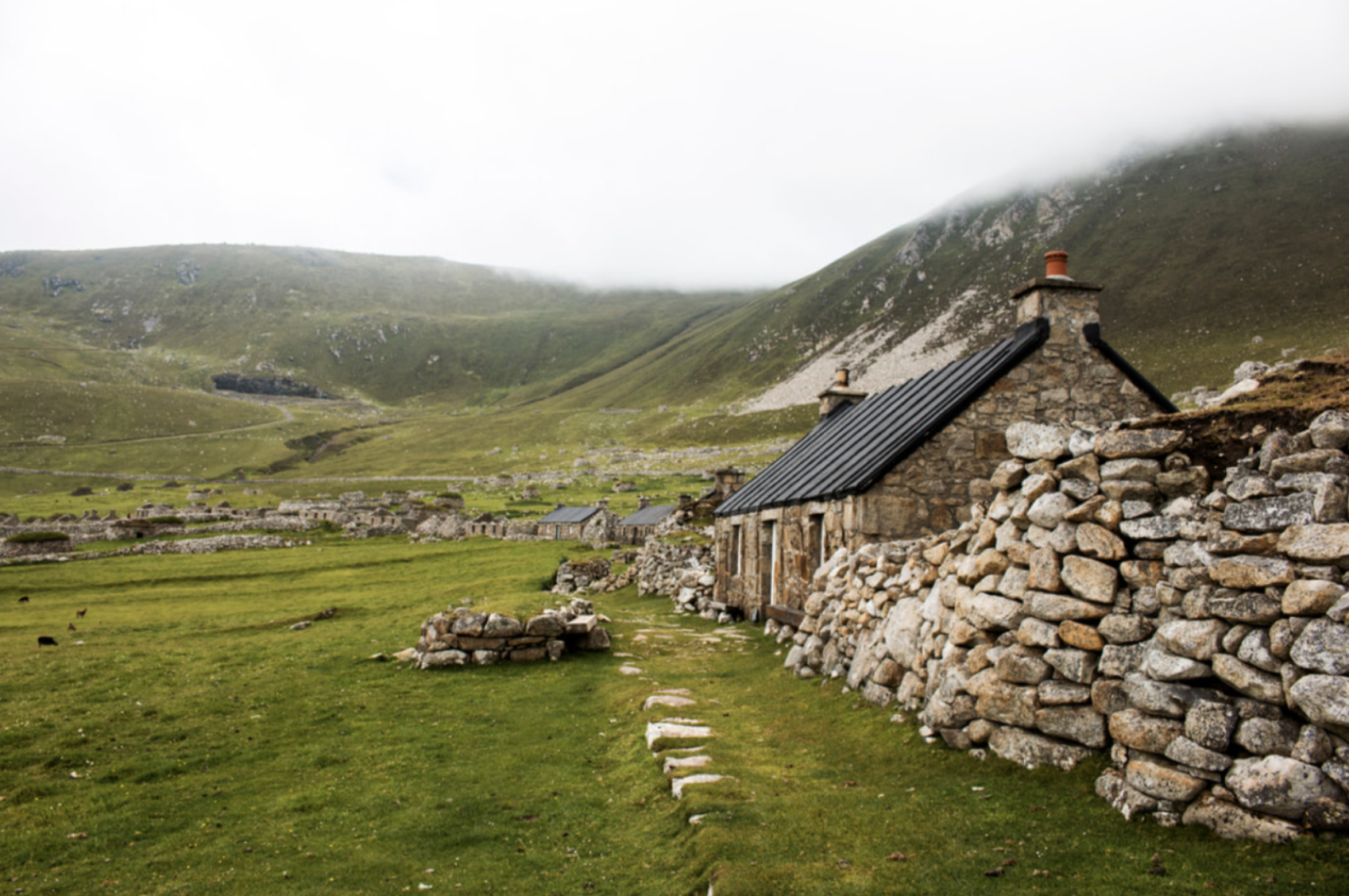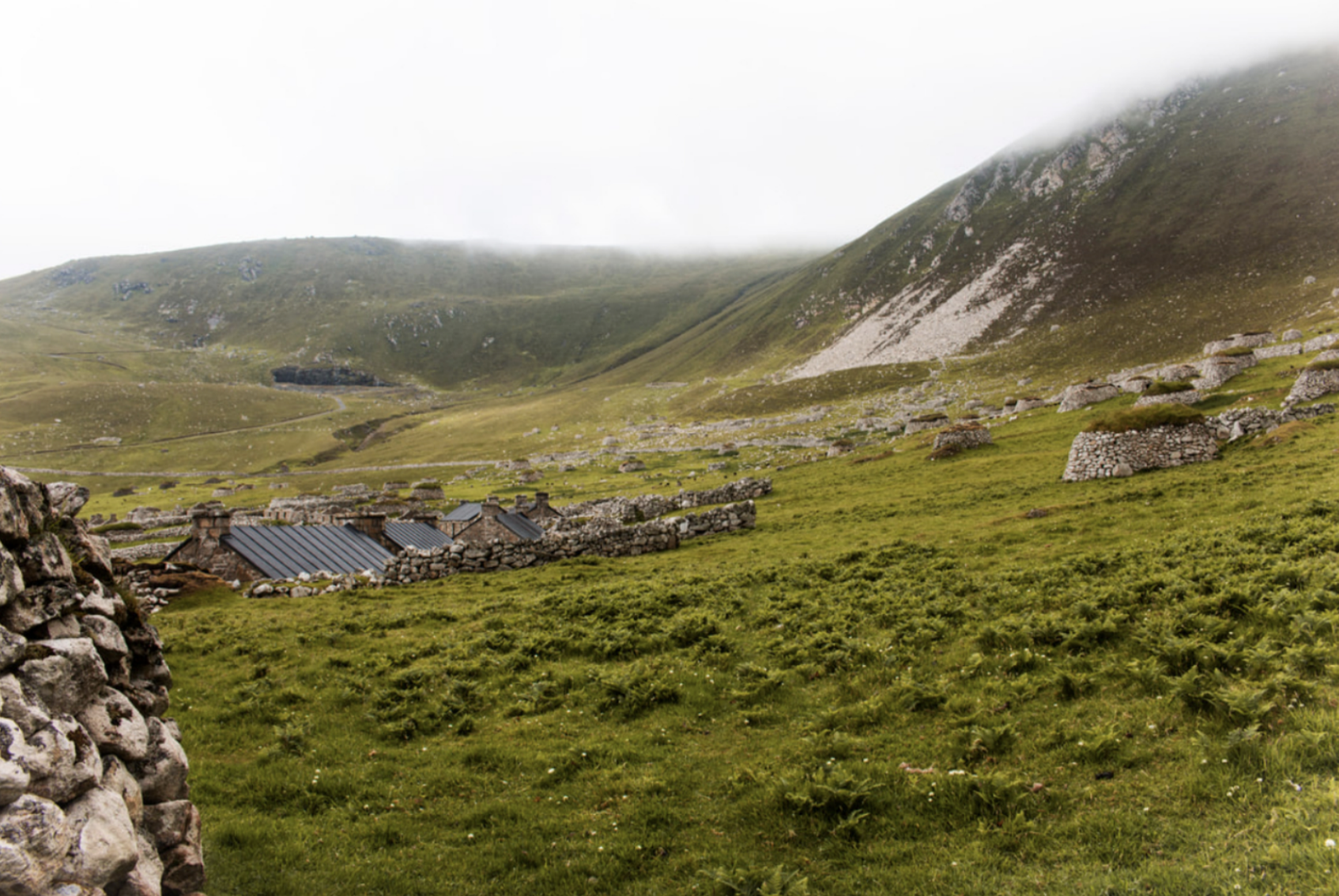St Kilda: an island on the edge of the world
St Kilda: the edge of the world
St Kilda is a weather-beaten archipelago off the west coast of Scotland, some 40 miles from the Outer Hebrides. The cluster of islands sits alone in the vast expanse of the unforgiving North Atlantic. As Britain’s most remote point, it feels like the final frontier, a wild and foreboding place that looms from the horizon, echoing noisily with the sound of hundreds of thousands of seabirds. This is the land of the seabird. Yet until 1930, it was home to a population of resilient islanders who had occupied the islands for some 2,000 years. Evidence of the lives they carved out on this remote outpost of the British Isles are scattered all over the islands today.
St Kilda's iconic Main Street
It’s three months since I visited, and I’ve struggled to put pen to paper to describe my experience – not because I don’t know what to say, but simply because it’s impossible to find the words that can describe what this experience and this island means to me.
St Kilda has been a place that I have longed to visit ever since my dad gave me a tatty copy of Tom Steel’s Life and Death of St Kilda as a teenager. Steel paints a poignant portrayal of the final years of an island community, an island battered by savage winter storms and cut off from the rest of the world for prolonged periods. The story of St Kilda and the St Kildans stuck with me through all my years growing up.
Village Bay. The building in the foreground is one of many hundreds of 'cleats' dotted around the Village Bay area.
As I began to explore the demise of our own small islands, the parallels between island communities and their people were both striking and inspiring, as well as bittersweet and heartbreaking. A common thread weaves island communities together, both in the past and the present. This thread speaks of resilience, determination, and a deep-rooted pride of place. To make landfall in Village Bay on a sunny day in July was nothing short of a dream come true for me.
Making up the archipelago are the main island, Hirta, as well as the islands of Soay, Boreray and Dun. Offshore stacks complete the jigsaw; the most notable – and essential to the St Kildans – were Stac Lee and Stac an Armin; towering columns that stand from the water like the jagged teeth of a sleeping dragon.
St Kilda in the background, Stac Lee to the right with Boreray to the left.
The archipelago formed some 55 million years ago when plate tectonics caused a split in the Atlantic Ocean. The islands are part of an eroded volcano that rises menacingly from the sea.
Today, three organisations, The National Trust for Scotland, Scottish Natural Heritage and the Ministry of Defence work together to further a continuing programme of conservation and research on the islands to ensure the care and protection of this dual World Heritage Site. St Kilda is one of a handful of places worldwide that boasts double World Heritage Status – this is awarded for its wildlife and archaeology or human history.
Dual World Heritage Status isn’t the only impressive title held by these remote and tantalising islands. St Kilda can also lay claim to the highest sea cliffs in the UK, with Conachair coming in at a jaw-dropping, vertigo-inducing 400 metres. Foula, Shetland’s most westerly island, comes second, with the Kame cliffs reaching 375 metres from sea level. The islands can also boast the highest sea stack in the UK, with Stac an Armin towering in at a dizzying 191 metres from the sea.
Getting to St Kilda
Hirta, a tour boat operated by Kilda Cruises from Leverburgh, Harris.
Passengers are ferried ashore to Village Bay on small zodiacs.
Getting to St Kilda is not that hard, although it has the potential to be quite difficult, which makes it all the more special to have had the opportunity to get in as ‘planned’. Over 50 per cent of tours are cancelled every year due to the weather – so we were extremely lucky to have had this opportunity.
St Kilda is notoriously inaccessible for much of the year, almost entirely cut-off from the mainland from October to May as storms ravage the North Atlantic, cutting off the narrow channel into Village Bay.
Several tour operators run daily excursions from Leverburgh in Harris. We travelled with Kilda Cruises. The trip cost £235 per person, leaving Leverburgh at 8 am and returning at 7.30 pm. Passengers have about four and a half hours ashore to explore the island at leisure before returning to the vessel for a tour of the coastline that boasts stacks, sea caves, geos, tunnels and blowholes – and Boreray, allowing a rare opportunity to view the vast bird colonies and the spectacular sea cliffs.
I was apprehensive about the journey after reading numerous warnings about large swells making for an uncomfortable crossing. however, the weather gods appeared to be on our side, and we had calm seas and a smooth crossing over. (The journey time from Harris is two and a half hours each way).
Boat trips are also available from Skye and North Uist.
The people
Village Bay's now deserted Main Street
With its dual World Heritage Status, St Kilda attracts ornithologists and naturalists from all over the world, but for me, the real lure was the people. I was desperate to explore this intriguing island community that was unable to survive beyond the 20th century. I wanted to get a real sense of the place that had supported an isolated, hardy population of islanders for over 2,000 years on this small storm-beaten cluster of volcanic rock.
Village Bay has a natural amphitheatre feel with the imposing slopes of Conachair and Mullach Sgar wrapping around it like a cloak. I was surprised to read that the temperature range in St Kilda was the narrowest in the UK (6℃ in summer and 3℃ in winter), as the day that we visited was warm. The heat felt further compounded by the surrounding slopes of Conachair, holding the heat within the bay, making it feel swelteringly hot and humid. It was hard to imagine how inhospitable the island could be in the depths of winter.
A strong link to the islands’ history is felt throughout Village Bay. As I walked down the famous Main Street, I imagined the people who had trodden the path before me, conjuring up images in my mind of what this once-proud community might have looked like one hundred years ago.
The built remains are scattered across the island, but most of them are concentrated under the steep, scree slopes of Conachair in and around Village Bay, with the row of traditional houses and hundreds of small cleats scattered around the landscape. These physical remains provide a real and tangible link to the cultural past of the St Kilda people. It’s difficult not to become lost in thought, with your head buried in the past, as you wander around, taking in the sights and sounds of this now quiet village where the lums no longer reek [chimneys no longer smoke].
The hills of Hirta are strewn with hundreds of cleats
Like most island communities, the St Kildans subsisted from the land around them, the physical limitations of their island providing a natural boundary, limiting what they could grow in the poor, acidic soils. Crops were grown with limited success, and islanders often imported grain from the mainland when crops failed.
The main staple of the island diet were seabirds, with fulmars, gannets and puffins being eaten for most daily meals – even breakfast! Every part of the birds was used, including the meat, oil and feathers.
This diet of seabirds was to be the islanders’ saviour and their downfall. It has been suggested that high mercury levels found in the seabirds poisoned the land. It’s also been suggested that the 10-day sickness that afflicted and killed so many babies in the first few precious days of life was caused by treating the umbilical area with oil stored in gannet stomachs – introducing bacteria to the site. Infant mortality was high, and by 1930 when the remaining 36 islanders were evacuated, only a handful of able-bodied men remained to work the land.
A few of the houses have been re-roofed and house workers and a small museum
Surprisingly, despite having some of the most productive fishing grounds on their doorstep, the St Kildans didn’t eat fish often or fish commercially. It was challenging to get the fish to a market from St Kilda, but, ultimately, the limited number of boats were too valuable to risk at the fishing. Boats were primarily used during the bird and egg harvesting period. St Kildans also lacked the appetite for fish, so accustomed were they to the oily seabirds that they disliked the taste of fish.
The majority of buildings now stand as roofless ruins
The death of St Kilda
The story of the demise of St Kilda is a poignant one that highlights the fragility of our rural island communities. In many ways, St Kilda is a magnified version of what has happened across rural island communities throughout Scotland and beyond.
For St Kilda, one of the most significant catalysts that led to the eventual evacuation of the island in 1930 was the influence of outsiders. The ministers and nurses drafted in to care for the spiritual and physical needs of the people were keen to see them adopt a more modern way of living. Often they failed to recognise the patterns of the St Kildan and how their way of life was born of a need to be entirely self-reliant – for better or worse.
Life on St Kilda was born out of a long-established need to be self-sufficient and to survive the long periods of absolute isolation from the wider world independently. These missionaries, sent in to assist what was often viewed as a ‘primitive’ people, failed to recognise that they unravelled the entire system in removing one or two of the delicate threads that made up the rich and complex tapestry of island life.
The St Kildan had developed a unique existence, based entirely around what was available to them in and around Hirta. Each life-giving element in this subsistence lifestyle provided a crucial link, supporting a delicate balance of survival, with each part giving strength to the next. Ultimately, what these well-meaning incomers did, was unravel an age-old system of living.
On 29th August 1930, the remaining 36 islanders were removed and relocated to mainland Scotland. The fires were stoked for the last time, and within a few hours, the last remaining flame went out, casting the island in darkness. For me, this is perhaps the most poignant aspect of the evacuation. For 2,000 years or more, a welcome flame burned in a hearth on the island, and with the absence of the people, the island’s fire was extinguished forever.
The gradual and steady loss of this subsistence way of life had meant that life had become untenable. The constant march of modernity that had altered mainland areas beyond recognition had, at last, washed up in Village Bay and carried the people with it on a tide of change – for better or worse.
St Kilda today
Today, St Kilda belongs to the elements. It is an island of birds that soar high above the cliffs and live noisily on the stacks and sheer rock faces. It’s a place that feels liminal – caught somewhere between this century and last, a place reclaimed by nature.
The imposing Stac Lee where seabirds and eggs were harvested annually
With almost one million breeding seabirds, St Kilda supports the largest seabird colony in the northeast Atlantic. It boasts 30 per cent of the UK’s gannet population and 25 per cent of UK puffins. Fulmars, so integral to the St Kildan diet, were not found anywhere else in the UK other than St Kilda until 1878 when they began to breed in Shetland – having followed cod boats back from the Faroe fishery.
The archipelago is dominated by the seabirds that nest here every summer
Britain’s last great auk, now extinct, was caught on Stac an Armin in 1840 – four years later, the species became disappeared when the last great auk was killed in Iceland.
Interestingly, only seven land birds breed regularly on the islands – including the St Kildan wren, a distinct subspecies unique to the islands. So far is St Kilda from the mainland that many land birds have not arrived here. Again, with the absence of people, some species that depend on a human population raising crops and working the land have vanished, including twite, corn bunting and corncrake.
The islands’ isolation has led to the emergence of two distinct sub-species – the St Kilda wren and St Kilda fieldmouse. Ironically, with the absence of people, we have also lost one of their other unique sub-species, the St Kildan house mouse, who couldn’t survive without its human population.
Subspecies are not uncommon on isolated islands. Shetland, for example, also has two species of the wren – the Shetland wren and the Fair Isle wren – both of which have distinct characteristics. As in Shetland, St Kilda’s wren has adapted to become slightly larger than its mainland counterpart. The St Kilda wren also has a thicker, more robust bill and paler plumage. We saw many of these beautiful little songbirds merrily hopping between buildings singing to the summer sky – it was magical.
The distinctive Soay sheep that roams free, without intervention. A primitive breed of sheep that is believed to date back to the Bronze Age
Another unique feature of the islands is the survival of the Soay sheep, a primitive native breed that has survived since the Bronze Age and now runs free, unmanaged – but monitored – on Hirta and Soay. They are generally brown or fawn, and, on average, there are around 1,200 that live on the islands, independent of any human intervention.
While on Hirta, I collected the hentilagets – wool naturally shed from the animals – and took it home. With the careful help of mam, my children made a beautiful artwork with the combed wool depicting the houses of Main Street – a picture that I will treasure alongside my memories of this memorable trip.
A little reminder of our day on St Kilda
I enjoyed the most incredible day on St Kilda. The islands spoke to me in a way that I can’t explain. The sense of loss was all around me as I walked amongst the houses of former islanders, and I couldn’t help but wonder at the heavy hearts those remaining islanders carried out with them as they waved goodbye to 2,000 years of life on that monumental day in 1930 when they evacuated the island.
I’m not blind to the fact that life was a daily and continual struggle for the islanders, but that doesn’t negate the fact that they were turning their backs on the only life they knew: without mechanisation, without cars, buses or even money. Theirs was a humble and honest way of living, governed entirely by the seasons and the cyclical patterns of the wildlife that they shared their island home with. The kirkyard carried generations of islanders, all in unmarked graves, as a formal tombstone was unnecessary and impractical, so close were they to their past that they knew where everyone lay at rest. Today, these are simply a cluster of unmarked graves on an island that we can only wonder at, in a place of islanders that we will never know yet never forget. It’s hard to sail away from St Kilda without the feeling that you have passed through a shrine – and I guess that’s why, despite its isolation, we will still be drawn to the island on the edge of the world. It feels like a place of pilgrimage and discovery, where we travel too to get answers and help us understand our own world a little better.
I suspect I left a little piece of my heart in Village Bay too.
Waving goodbye to St Kilda - what a place, what a day!






















